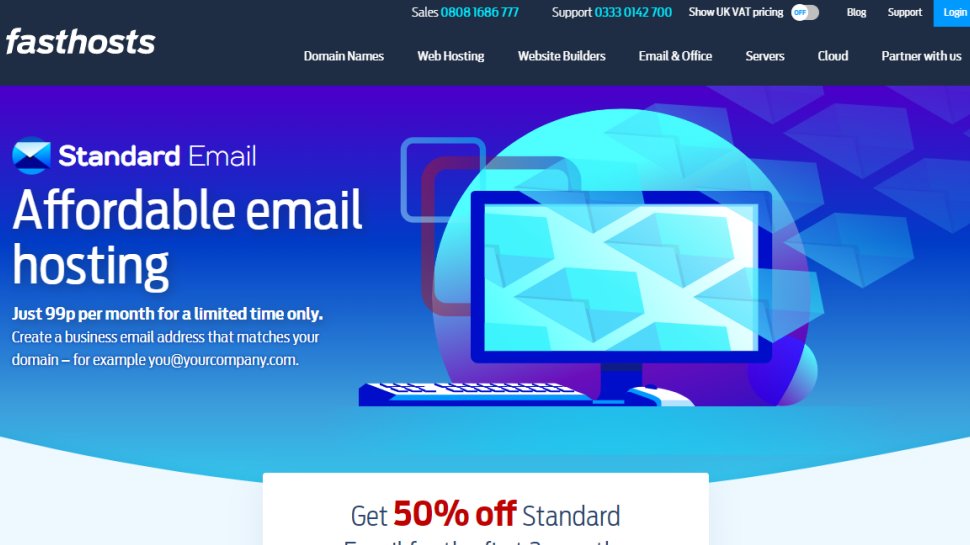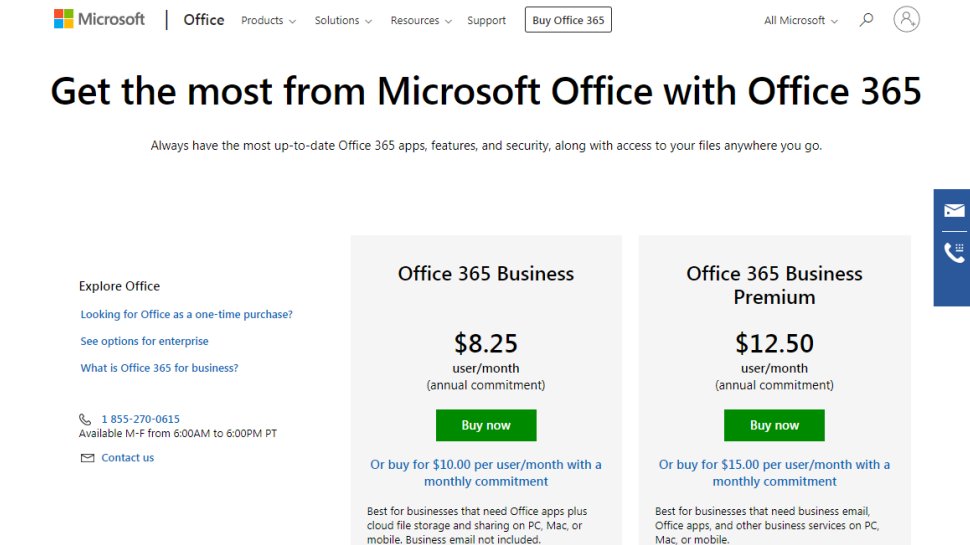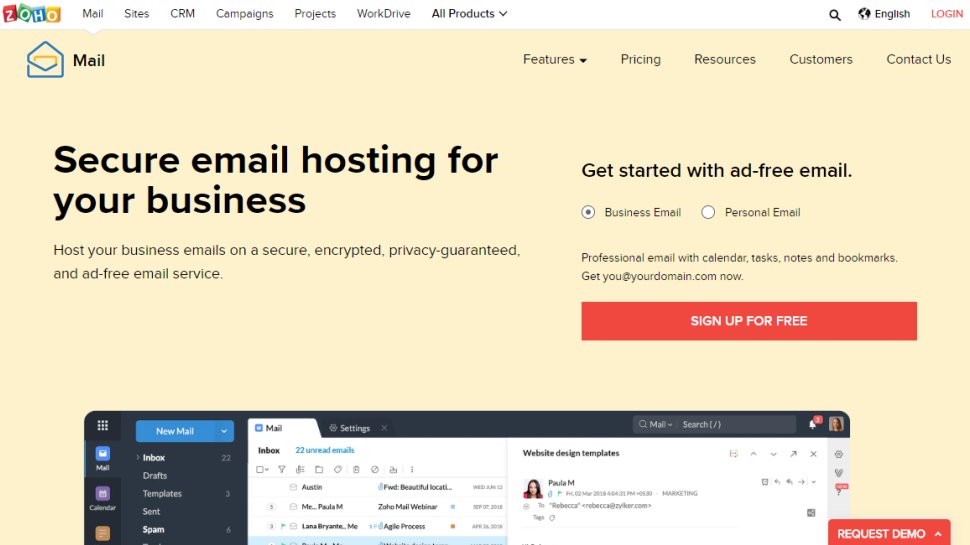Email hosting is much like web hosting services. Getting hold of an email account is easy – sign up with an ISP, register with Google, buy a web hosting account – but free and standard packages won't always deliver the quality that professional users need.
Email hosting plans are an easy way to get a more efficient and reliable service. Exactly what's included depends on the provider, but you might get support for larger attachments (up to 50MB), 50GB or more storage space for your inbox, online storage for easy file sharing, bundled apps like Microsoft Office online, Exchange and Active Directory support for business users – not to mention 24/7 support if anything goes wrong.
Your email will work with a custom domain (address@yoursite.com), and it's typically straightforward to set up. You can use an email hosting plan to effectively replace your web host's service, or you can try one without having any hosting at all.
With quality services priced under $1 per month per user, and free trials available, it's easy for anyone to check out the email hosting market. Whether you're after an individual account or would like to cover your entire business, read on for five great providers that you might want to check out first.
The best email hosting at a glance

1. Bluehost email hosting
This is exclusive to TechRadar; you won’t find it anywhere else
If you are a small business with a small headcount and don’t want to spend hundreds of dollars on email accounts, then consider this. From EIG-owned Bluehost comes an exclusive business email package for TechRadar readers where you get unlimited email accounts and email storage for as little as $2.75 when paying for three years; that’s a mere $99 for the duration of the term. Is it truly unlimited though?
Bluehost says that they do not enforce any official limitations. Furthermore, they add “while email account creation is unlimited, these rely on the file storage available on the account. Therefore customers need to be operating within the Terms of Service to ensure resources are available to fully enable email functionality. Customers operating within the Terms of Service have yet to come up against technical boundaries for email, domains, or websites”.
What’s the catch then? For a start, while you get POP3 and IMAP4 plus 24/7 support, this is more of a barebone solution. You get to choose between three webmail applications (the equivalent of Outlook.com or Gmail.com); Horde, Roundcube or Squirrelmail.
You can of course configure an email client like Mail for Windows 10 or Mozilla Thunderbird to read your emails offline. Creating a new email address is a doddle thanks to an easy user interface.

2. Fasthosts email hosting
Ideal for those on a budget
Email hosting can seem expensive, and that's largely because the big companies are forever competing to offer the largest amounts of inbox and file storage space. That's great if you need it, but not so much for light email users looking for a bargain.
Fasthosts Standard Email plan is a stripped-back email hosting plan which offers the bare essentials for a very low price.
Signing up gets you two email addresses with 2 x 2 GB mailboxes. You'll also get an antivirus, POP3 and IMAP4, 24/7 support, and webmail access. That's limited, but look at the price: just $2.60 (£1.99) a month on the annual plan (at the time of writing, you can get 50% off). If your users genuinely don't need the gigabytes available elsewhere, Fasthosts more basic package could make a lot of sense.
Fasthosts also offers a more capable Exchange Email product with a 50GB inbox, access via Outlook's web app, and even a free domain for the first year. It's priced at $5.8 (£4.49) per month for 5 or more users with the annual contract. You can also choose a 100GB inbox for $13 (£9.99). As before, Fasthosts is focusing on price more than power, but if you only need a basic Exchange account, there's plenty of value here.

3. Microsoft 365
You’ll get much more than just email hosting…
Microsoft Office 365 isn't just a powerful suite of productivity apps. It also throws in a very capable email package, and for less money than some providers charge for email alone, which could make the service worth a place on your shortlist.
Microsoft 365 Business Basic offers support for 150MB attachments, for instance, three times the size allowed with even some premium competitors. 50GB of storage per user (and a custom email domain address) means you'll be able to keep your messages for a very long time, and there's 1TB of online storage available in your OneDrive account.
Access to Office Online enables working with Word, Excel, OneNote and PowerPoint documents from within your browser, and there's a whole range of business-friendly extras: calendars, online conferencing, intelligent search, workflow automation and more.
If you don't have Office 365 already, the Business Basic price of $5 a month (for annual billing) looks like good value to us. If you're solely interested in business class email, though, Microsoft's Exchange Online Plan 1 provides Exchange accounts for $4 per user per month on the annual plan.

4. Zoho Mail
Boasts a range of options, with a free plan to boot
Zoho Mail is a hosted email service with a bundled online office suite, and a stack of other extras. Several of the newest features Zoho Mail introduced, are: Offline Mode, undo mail, recall mail, huge attachments (up to 250MB) and a few others.
A free plan gives you five mailboxes with up to 5GB per user, a 20MB attachment limit and webmail access. A referral scheme could get you support for a further 25 mailboxes (at the time of writing the referral program wasn't available due to remodeling).
If that's too basic, the Standard plan gets you IMAP and POP support, 30MB attachments and 30GB of storage, 5GB file storage space, and support for working with multiple domains. That's more capable than some of the premium competition, and includes the same productivity tools as the free suite, yet still only costs $3 per user per month, billed annually.
Zoho's Professional plan gets you 100GB of storage (per user), 40MB attachments, support for Active Directory groups, and more. It's yours for $6 per user per month (billed annually), not bad at all for the storage space and features you're getting. Also, Lite plan is available with less features, but it's only $1 per user per month, billed annually.

10 things to look for in your next email hosting
If you want to host email accounts together with your website, then you should look at these email features before signup.
Most hosting companies will offer the ability to host your own email (something like email@yourdomain. com). Your package will include a number of email accounts – usually between 1-10 for basic hosting.
You’ll be given access to your own email control panel to set up your accounts. Using email requires two things: an email server and an email application, this could be an email client such as Outlook, or alternatively access to Webmail like Gmail or Yahoo.
The email server is a piece of software that runs on the server and is constantly connected to the internet. It receives and processes any mail sent to it and sends out any mail you send.
The email client is an app that runs on your PC, phone or tablet and enables you to send, receive and organise your emails, e.g. Microsoft Outlook. The client checks the mail server for messages and downloads them for viewing. It is a control panel for reading and writing messages.
The good news is that most email clients can connect with most email servers, you can even connect multiple email servers to work with multiple email accounts.
So your work and personal emails can be accessed from the same email client. The more popular email clients such as Outlook give you more features (calendars, tasks etc.) than using webmail.
Webmail is a web-based email interface that can be accessed in a web browser is often faster and more convenient because it accesses the stored data more directly without the user having to download software locally.
Emails can be checked from any device with access to the internet. Email protocols are a set of rules that help the client to send the information to or from the mail server. Two of the most common email protocols are POP and IMAP:
1. POP (Post office protocol) Applications like Outlook will use POP to download emails from the server to your computer and then delete them on the server.
2. IMAP (Internet message access protocol) IMAP is more advanced than POP, with IMAP, emails are stored in the mail server and can be accessed from any clients anywhere if they all use IMAP.
Mail data is kept on the server as well as your computer, until you delete the mail. When comparing hosting packages, be sure to choose one with full IMAP support.
Exchange Exchange is the gold standard email protocol – the most expensive option of the three, but for good reason. It’s a Microsoft protocol that gives you the power to sync tasks like IMAP does, but with the added ability to share contacts and calendars among employees.
If you can afford to pay the extra cost (around $9.99 per month per mailbox), you will reap the benefits of its advanced functionality and tools which can be used even when you are on the move.
You might also want to check out our other website hosting buying guides:

0 comments:
Post a Comment